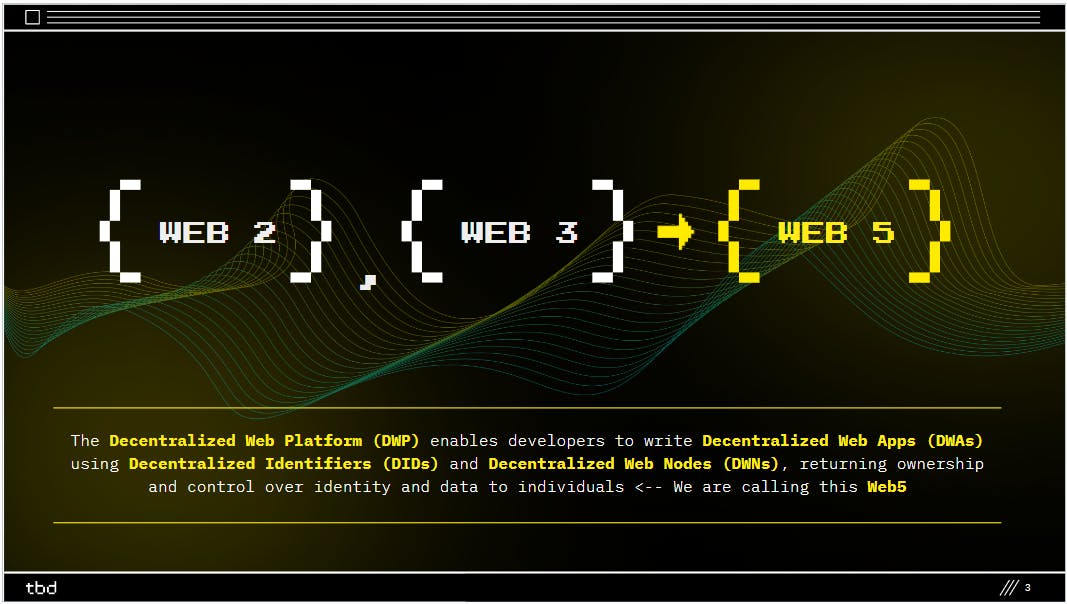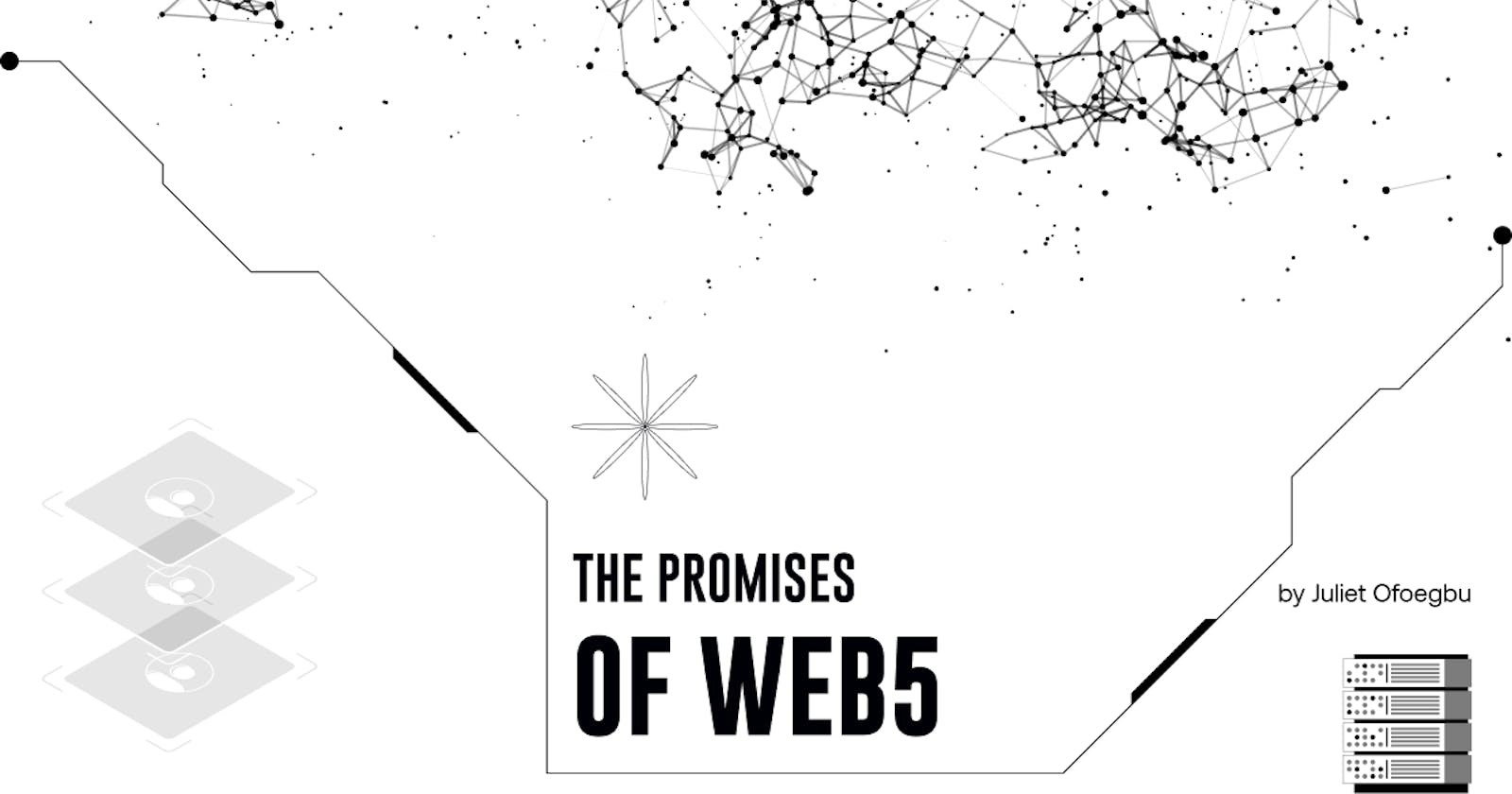The Promises of Web5: Decentralization, Data & Identity Control, and Personalization
Table of contents
Introduction
In this article, we'll take a closer look at Web5, discussing how it's different from the earlier versions of the web, how it can make things more simplified and personalized, how it can make data more private & secure, and how it can transform the way companies and people use the internet. We'll look into the promises of Web5, what has been achieved so far, and see if truly it can deliver on the promises made.
Generations of the Web
Here we look at how the web or internet has evolved and the improvements it made during each phase up until the current one - Web5.
First generation of the Web: Web1.0
Over the past 3 decades, the Internet has evolved in a lot of ways, from the way we consume content, to the way we create them, to the way they are distributed. We started with simple, non-interactive websites (web1) that allowed us to be consumers, unable to contribute or interact.
However, with each iteration comes more improvements and solutions to previously existing problems. So, web2 came like a knight in shining armor.
Second generation of the Web: Web2
The current evolution of the web (web2) emerged and it felt like the long-awaited savior. The ability to contribute to the web, interact with others, and have online identities became possible. The improvements that came with this version of the web made us blind to see the inadequacies. We were basically giving our data and identities to big companies and we were too excited about experiencing an evolution to even think much about it.
In recent times, those inadequacies that we didn’t pay much attention to, like a phoenix, are coming back to eat at us. Big web2 corporations collect, control, misuse, and even sell users’ data. Those companies that don’t necessarily sell their customers’ data share access to them with other big firms. The interesting part is that we all signed up for it in the “Privacy Policy” that nobody ever reads. Even with data privacy laws set in place over the years, it’s like a drop of water in the ocean as nothing has changed.
Third generation of the Web: Web3
When the term web3 got out, it piqued a lot of interest as people were excited about the future that this new evolution of the web promised to bring. However, like every new tech, web3 did come with its own faults. While it solved/is still solving many underlying issues facing various industries, it still hasn’t provided standard solutions to the issue of users’ data being owned and controlled by enterprises.
Like an answered silent prayer, a true solution to these crises was birthed.
What is Web5?
“Web5?” “Web what?” “When did we move from web3?” “But I was just getting the hang of web3”
These are the usual responses received when people hear of web5. It isn’t unexpected but it is worth noting that web5 isn’t an entirely new concept as it is built in the context of web2 (in terms of social interactions) and in the context of web3 (in terms of decentralization). Hence, it combines the best features of both.
Web5 is a decentralized web platform. Not just another but the decentralized web platform. It is the further evolution of the web that gives users complete ownership and control over their data and identities.
So on Web5's promise of decentralization, data and identity control, and personalization, what does this all mean?
Decentralization: Decentralization, according to the Oxford Dictionary means the transfer of control of an activity or organization to several local offices or authorities rather than one single one. Web5 being a decentralized platform means that it gives power back to users rather than a central authority.
Data and Identity Control: It promises to give users complete ownership and control over their data and identities.
Personalization: This means that it will grant developers the ability to build applications that can be tailored to individual's needs and preferences.
This platform provides the necessary tools to create fully decentralized apps and protocols that will put the users first by helping them reclaim their identity on the web.
Below is a pictorial representation of the idea behind the creation of Web5.

When was Web5 invented?
The term “Web5” first gained attention in 2009 when Tim Berners-Lee, inventor of the World Wide Web, described it as an “open, connected, intelligent web” during a Ted Talk.
After that, it wasn’t exactly a topic of discussion until 2022 when Jack Dorsey, former CEO of Twitter (now called X) and current CEO of Block Inc (re)introduced the term. In June 2022, TBD, the company responsible for its development announced the launch of Web5 via a tweet. The platform is rooted in Web3 technology but promises a more decentralized web experience.
The term Web5 came up by combining Web3 and Web2 (3 + 2 = 5). It doesn't follow a "Web4" concept.
Components of Web5
There are three main components or pillars that enable developers to create decentralized apps on Web5:

Decentralized identifiers (DID): These are self-generated and self-owned identifiers that help confirm users’ identities. Typically, a DID is a long piece of alphanumeric characters consisting of three parts: the scheme, the method on which the DID was created, and the DID method-specific identifier unique to every user. An example of a generated DID is "did:ion:EiS1AiLCJ4IjoiQmc2SzgHlwZSI6IkRlY2VudHJhbGl6ZWRXZWJOb2RlIn1dfX1dLCJ1cGRhdGVDb21taXRtZW50IjoiRWlCbjNKNmx2cHNrcWJNUzd1dFlzazh6T3BPdHZCOE5GbWZ".

Verifiable credentials: These are standards for ensuring that information about an individual is true albeit not disclosing the full information.
For instance, proving that you’re financially capable of taking a loan but not showing the lender your bank statement or current income.
Decentralized Web nodes (DWNs): These are data storage for users to store their data obtained from any app they interact with. It also aids in relaying messages between users for apps that work without a central hub.
What are DWAs:
DWAs stands for Decentralized Web Applications. Developers can build DWAs on Web5 using a Decentralized Web Platform(DWN). Building applications on a decentralized platform like Web5 gives you control and management power over your identity and data. DWAs are to Web5 what Progressive Web Apps(PWAs) are to Web2.
What is the difference between Web2, Web3 and Web5?
In simplified terms, Web2 brought social media and user-generated content, making the Internet more interactive, easy to use, and collaborative. Its major weakness was that it relied on centralized platforms. Web2 surely set the foundation, but its personalization and privacy features were limited.
Web3, on the other hand, focused on decentralization and Blockchain. Web3 paved the way for decentralization, but its focus was mainly on the use cases of blockchain technology where it has made more progress.
Then Web5 came into the picture, another decentralized platform. It's not just decentralized; it's intelligent, adaptable, and understands users deeply. Perhaps that's why it was called the “emotional web.” Web5 offers a highly private, personalized, and secure digital experience that goes beyond social interaction(Web2) and blockchain(Web3).

Examples of Web2, Web3, and Web5 applications:
Web2 Apps: X(Formerly Twitter), Facebook, TikTok, Instagram, Youtube, Zoom, Netflix, and so on.
Web3 Apps: Uniswap, Pancakeswap, Decentraland, Brave browser, Ethlance, and so on
Web5 Apps: Bluesky which is a decentralized social networking application created by Jack Dorsey, the former Twitter CEO. Damus is another decentralized social networking application created by a group of 44 software developers under the direction of William Casarin. Zion is another web5-based social media networking platform where users can share content and freely communicate with themselves without fear of being watched by third parties.
Web5 integration into current technologies
Artificial Intelligence (AI): Integrating AI into Web5 enables the automation of various tasks, streamlining processes and improving efficiency. In an article published on Dev.to by Rizel Scarlett from the TBD team, we learn about how Web5 meets Generative AI.
There, we are introduced to a Web5 application, Netonomy, built by Anthony DeMattos. Netonomy, according to Anthony's GitHub readme is "an application that allows users and organizations to own their digital identities, data, and finances".
Blockchain: Blockchain eliminates the need for a central authority, enhancing security and reducing the risk of fraud. Web5 technologies can be integrated into Blockchain to build apps just like what Web5 Nexus is doing. Web5 Nexus provides developers with tools, resources, and support to help them build any Web3 product.
Exploring applications that can be built with Web5
In the official documentation, it's noted that Web5 can be used to build Todo, Travel, and Music apps. However, the potential of Web5 goes far beyond these categories. Let's delve into more applications that can be built using Web5, exploring how they differ from Web2 and Web3 applications.
Intelligent Personal Assistants
Immersive Virtual Reality
Decentralized Finance (DeFi)
Home Automation
Web5 applications are redefining the expectations of users for their digital interactions, ranging from developing intelligent personal assistants to producing immersive virtual reality experiences.
To get started building Web5 applications, go through the quick start guide put together by the TBD team.
NB: Good news for developers, Web5 can also be integrated into an existing Web2 project or a new Web2 project built using JavaScript frameworks. For now, it can be integrated into frameworks - Next.js and Vue. To do this, you'll need to set up Web5 SDK in a Next.js or Vue project. Refer to the official documentation on how to integrate Web5 in a Next.js project and a Vue project.
Common questions about Web5 and their answers
Question: How will Web5 simplify complex processes?
Answer: What piques people's interest in the tech space isn't the next new flashy tech name. What people are most interested in is how a new technology or software will solve a problem or simplify already complex problems. Hence the reason for this question.
Web5, the latest advancement in internet technology, is set to make processes more straightforward and efficient in different areas. This is due to the algorithms embedded in Web5 that have the capability to take over repetitive and time-consuming tasks. This leads to increased efficiency and improved decision-making capabilities for businesses.
Question: How can it be used in everyday life?
Answer: Web5 will become an integral part of daily life, acting as a seamlessly integrated digital companion. Picture a scenario where your digital surroundings adjust to your likes, foresee your requirements, and elevate your interactions. This transformation extends from smart homes to personalized virtual assistants, reshaping how individuals interact with technology.
Question: How can it change the narrative for companies and individuals?
Answer: Companies and individuals that embrace Web5 gain a competitive edge in a rapidly evolving digital landscape. When companies and individuals adopt Web5, they position themselves to thrive through intelligent and decentralized technologies. This strategic move to adopt Web5 empowers businesses to provide top-notch products and services, while individuals enjoy a more personalized and secure online experience.
Conclusion
Web5 isn't starting from scratch. It learns from the good things in the older versions of the internet (like Web2 and Web3) and combines them to make something even better. One of the cool things about Web5 is that it's smart. It can understand what you need and change based on that while giving you control of your data and digital identity.
Ready to explore Web5? Get started here.
References:
https://developer.tbd.website/blog/what-is-web5/
